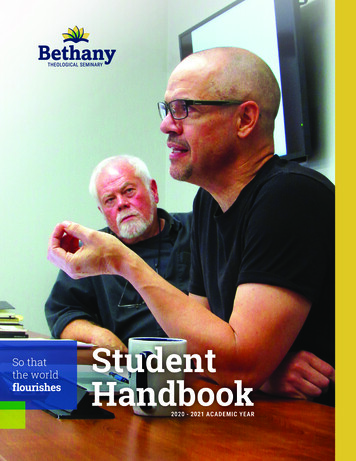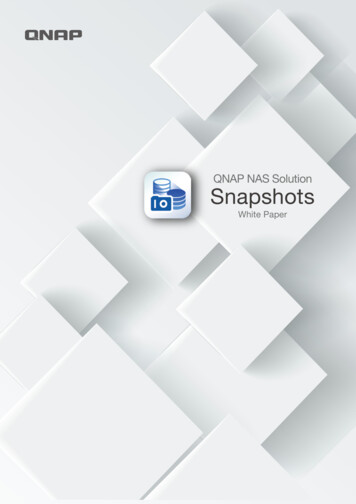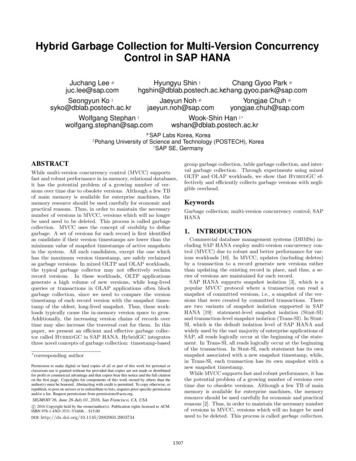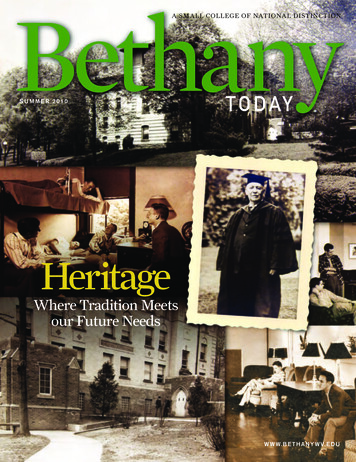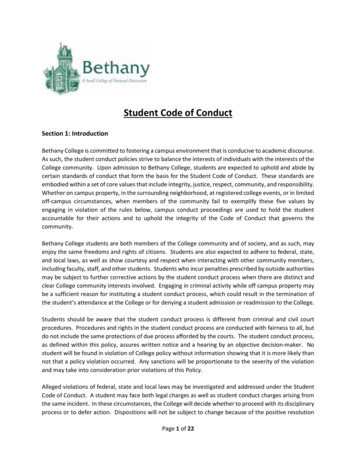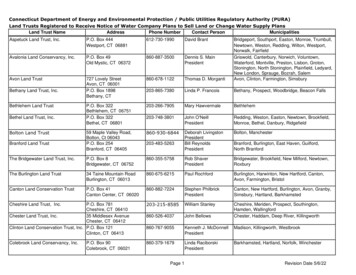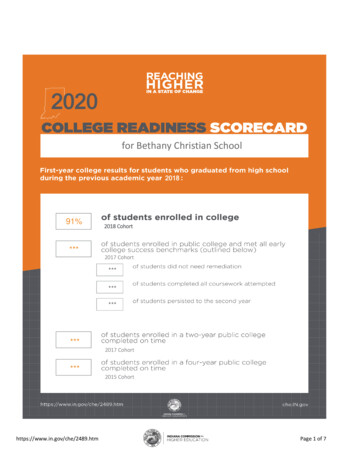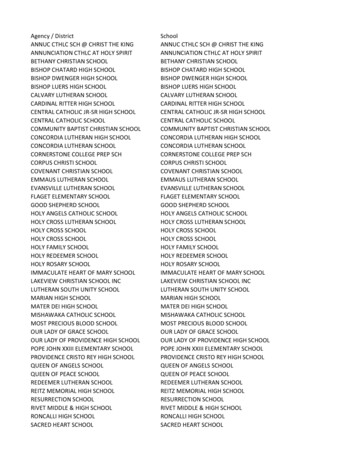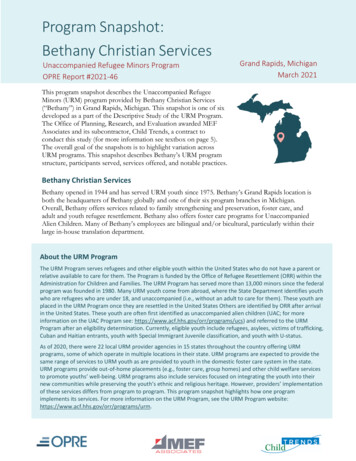
Transcription
Program Snapshot:Bethany Christian ServicesUnaccompanied Refugee Minors ProgramOPRE Report #2021-46Grand Rapids, MichiganMarch 2021This program snapshot describes the Unaccompanied RefugeeMinors (URM) program provided by Bethany Christian Services(“Bethany”) in Grand Rapids, Michigan. This snapshot is one of sixdeveloped as a part of the Descriptive Study of the URM Program.The Office of Planning, Research, and Evaluation awarded MEFAssociates and its subcontractor, Child Trends, a contract toconduct this study (for more information see textbox on page 5).The overall goal of the snapshots is to highlight variation acrossURM programs. This snapshot describes Bethany’s URM programstructure, participants served, services offered, and notable practices.Bethany Christian ServicesBethany opened in 1944 and has served URM youth since 1975. Bethany’s Grand Rapids location isboth the headquarters of Bethany globally and one of their six program branches in Michigan.Overall, Bethany offers services related to family strengthening and preservation, foster care, andadult and youth refugee resettlement. Bethany also offers foster care programs for UnaccompaniedAlien Children. Many of Bethany’s employees are bilingual and/or bicultural, particularly within theirlarge in-house translation department.About the URM ProgramThe URM Program serves refugees and other eligible youth within the United States who do not have a parent orrelative available to care for them. The Program is funded by the Office of Refugee Resettlement (ORR) within theAdministration for Children and Families. The URM Program has served more than 13,000 minors since the federalprogram was founded in 1980. Many URM youth come from abroad, where the State Department identifies youthwho are refugees who are under 18, and unaccompanied (i.e., without an adult to care for them). These youth areplaced in the URM Program once they are resettled in the United States Others are identified by ORR after arrivalin the United States. These youth are often first identified as unaccompanied alien children (UAC; for moreinformation on the UAC Program see: https://www.acf.hhs.gov/orr/programs/ucs) and referred to the URMProgram after an eligibility determination. Currently, eligible youth include refugees, asylees, victims of trafficking,Cuban and Haitian entrants, youth with Special Immigrant Juvenile classification, and youth with U-status.As of 2020, there were 22 local URM provider agencies in 15 states throughout the country offering URMprograms, some of which operate in multiple locations in their state. URM programs are expected to provide thesame range of services to URM youth as are provided to youth in the domestic foster care system in the state.URM programs provide out-of-home placements (e.g., foster care, group homes) and other child welfare servicesto promote youths’ well-being. URM programs also include services focused on integrating the youth into theirnew communities while preserving the youth’s ethnic and religious heritage. However, providers’ implementationof these services differs from program to program. This program snapshot highlights how one programimplements its services. For more information on the URM Program, see the URM Program website:https://www.acf.hhs.gov/orr/programs/urm.
Bethany’s URM program is the largest in the country.Bethany operates their URM program in four of theirbranches in Michigan: Grand Rapids, Kalamazoo, TraverseCity, and Madison Heights. With the exception of thesection below on URM program participants, this snapshotfocuses only on the URM program in Grand Rapids, whichis the largest branch. The Grand Rapids office has 77 staffwho run the URM program. These staff help provide casemanagement services for URM youth and their fosterfamilies to ensure that their needs are met. Bethany worksclosely with the Michigan Department of Health andHuman Services (MDHHS) to ensure the services providedto URM youth mirror those provided to youth in thedomestic foster care system.Key Facts about the BethanyURM Program Year program started: 1975 Custody arrangement: Public—State Number of youth who enteredprogram in FY2014-FY2018: 373 Number of youth served by theprogram in FY2018: 353 Number of program staff as ofSeptember 2019: 77Bethany URM program participantsFrom federal fiscal year (FY) 2014 to FY2018, 373 youth entered Bethany’s URM program in theirGrand Rapids, Kalamazoo, Traverse City, and Madison Heights locations. The graphs below showthe characteristics of these 373 youth.Eligibility emale30%Trafficking victim,asylee, or entrant70%EthnicityRegion of OriginAmericas43%Eastern Africa19%Central Africa14%Central, South, or East AsiaMiddle EastWestern Africa12%7%6%Age at Entry17 or older*16151412 or 1311 or youngerYoungestHispanicEritrean, Tigrinya, Somali, Saho,Oromo, or Amharic/AmharaRohingyaBanyamulenge, Congo,Tutsi, or HutuHazaraOther40%16%9%9%6%21%Initial Living Arrangement62%20%6%3%5%4%MaleSemiindependent 14%living3% Group home49%Average r care34%218Notes: These figures are based on original analysis of data from ORR’s Refugee Arrivals Data Systems (RADS). To protect the identity ofprogram participants, categories with less than 10 youth were combined with other categories. Therefore, countries of origin were collapsedinto global regions. No youth came from Europe or Australia. For ethnicity, the next largest ethnicity grouping placed within ‘other’ includedIndigenous Guatemalan. For living arrangement, some states define living arrangement types in different ways, which can lead to variation inhow programs report living arrangement types. *On rare occasions, there is an age redetermination done after a youth enters the programBethany Christian Services 2that determines that they were 18 or older at entry (this does not change their program eligibility).
Bethany URM program servicesServices offeredBethany provides a wide array of services for URM youth within their agency and throughpartnerships with external organizations. Bethany provides the basic services expected from a childwelfare agency for domestic youth, such as case management and permanency services, in additionto services tailored to the needs and experiences of URM youth. Below is a summary of the servicesavailable to URM youth and who provides them.Table 1. Services provided within Bethany and through partnersTypes ofservicesProvided within BethanyProvided bothwithin Bethany andthrough partnersProvided throughpartnersAcculturationservicesCultural orientation/integrationclasses, one-on-one discussions,activities to support ethnic andreligious heritage, opportunities tosocialize with other youth, andmentorshipN/AN/AHealthservicesMental health screenings, individualtherapy/counseling, and services forsurvivors of tortureRoutine doctor visitsand substance abusetreatmentPsychotropic medicationmanagementEducationservicesTutoring, tuition assistance,workforce development training,and job search assistanceN/AEnglish classes, GEDclasses/testing, andassistance withcollege/vocational schoolapplicationsLife skills/independentliving trainingor servicesFinancial literacy, householdmanagement, finding/managinghousing, personal care and hygiene,access to transportation, andproblem solvingN/AN/ALegalassistanceservicesN/AN/ALegal services forestablishment andmaintenance of legalresponsibility within thefoster care system,immigration relief,adjustment of status,work authorization, andlegal advocacy servicesPermanencyservicesReunification effortsRelativesearch/engagementN/AData source: Survey of URM Program Directors administered in Fall 2019.Bethany Christian Services 3
Living arrangements availableIn addition to the wide variety of services available to URM youth, Bethany offers many differenttypes of living arrangements, either directly or through partnerships with external providers (seeTable 2 below). Living arrangements are determined based on the needs and required level of carefor each youth.Table 2. Living arrangements available within Bethany and through partnersThrough Bethany Family-based foster careKinship care/relative foster careIndependent living arrangementsSemi-independent/supervised living facilitiesTherapeutic foster careMedical foster homesGroup homesThrough partners Residential treatment facilitiesData source: Survey of URM Program Directors administered in Fall 2019.Coordination with the child welfare systemMichigan has a public custody arrangement, meaning MDHHS (the public child welfare agency) haslegal custody of URM youth in Bethany’s program. MDHHS employs “monitors” who overseecaseloads of URM youth; they are responsible for reviewing services and service referrals for youth,approving placements, and eventually closing cases when youth age out of care. They also supportBethany on an ad hoc basis on cases, service provision, and policy. Overall, Bethany reported on aFall 2019 survey that, in addition to licensing foster parents, the local DHHS is “highly” involved inproviding direct services for URM youth. Bethany also reported that program staff interact “daily”with the local DHHS regarding services for URM youth.Bethany innovative practicesBethany has many notable innovative practices in their URM program. We highlight three of thesepractices below to facilitate peer-to-peer learning among URM programs.Variety in available living arrangementsAs described above, Bethany offers a wide variety of living arrangements to URM youth. In terms of fostercare, Bethany trains all foster parents as therapeutic/treatment foster parents. Bethany also offers a URMgroup home for boys under age 18 where staff are available on site at all times. Bethany also has severaldifferent independent or semi-independent living arrangements available. In one of these arrangements,known as “Independent Living Plus,” youth live in a home managed by Bethany and pay rent directly toBethany. Independent Living Plus is available for youth ages 17 to 19 for up to one year. The house isstaffed part time and youth can choose to come and go as they please as long as they do not miss classesor meetings. Staff regularly meet with each youth and provide life skills classes or other independentliving services. Bethany staff said that this arrangement is particularly good at providing a step-downbetween group homes/foster homes and full independent living arrangements.Robust mental health servicesBethany provides robust mental health services in-house to URM youth. Bethany’s staff includes boththerapists and behavioral health specialists. By providing these services in-house, staff feel they canBethany Christian Services 4
provide more consistent support tailored to the unique needs of URM youth. Weekly group therapy isprovided to youth who live in group homes. Additionally, as mentioned above, all foster parents are alsotrained to provide therapeutic foster care, which means they receive training on how to support youthwith severe mental health needs.Refugee-focused high schoolSince 2014, Bethany has partnered with Lighthouse Academy to provide a high school specifically forrefugee youth. About half of the students in this school are URM youth, while the other half are refugeeyouth resettled with families and unaccompanied alien children. The school is specifically designed tosupport youth with a history of trauma. They allow youth time to adjust to a school environment andyouth are able to stay in the school until age 22 to complete their high school diploma.For more information on rand-rapidshttps://bethany.org/contact-us(616) 224-7550About the Descriptive Study of the URM ProgramThe Office of Planning, Research, and Evaluation (OPRE) in the Administration for Children andFamilies awarded MEF Associates and its subcontractor, Child Trends, a contract to conduct adescriptive study of the URM Program to better understand the range of child welfare services andbenefits provided through the URM Program. The study included three primary components to answerour research questions: a survey of URM providers, State Refugee Coordinators, and child welfareadministrators; analysis of existing program data; and site visits to six URM programs (conductedbetween November 2019 and January 2020). This snapshot highlights one of the programs visited bythe study team. Please see our study overview for more information on the study, including thestudy’s research questions: rogram. The Federal Project Officer is Gabrielle Newell at OPREand the Project Director is Sam Elkin at MEF Associates.This report is in the public domain. Permission to reproduce is not necessary. The views expressed in thispublication do not necessarily reflect the views or policies of the Office of Planning, Research, and Evaluation(OPRE), the Administration for Children and Families, or the U.S. Department of Health and Human Services. Thispublication was developed under contract number HHSP233201500077I. This report and other reports sponsoredby OPRE are available at https://www.acf.hhs.gov/opre.Suggested citation: Child Trends & MEF Associates. (2021). “Program snapshot: Bethany Christian Services.” OPREReport #2021-46. Washington, DC: Office of Planning, Research, and Evaluation, Administration for Children andFamilies, U.S. Department of Health and Human Services.Bethany Christian Services 5
Bethany Christian Services Unaccompanied Refugee Minors Program OPRE Report #2021-46 Grand Rapids, Michigan March 2021. About the URM Program . Refugee-focused high school Since 2014, Bethany has partnered with Lighthouse Academy to provide a high school specifically for refugee youth. About half of the students in this school are URM youth .
